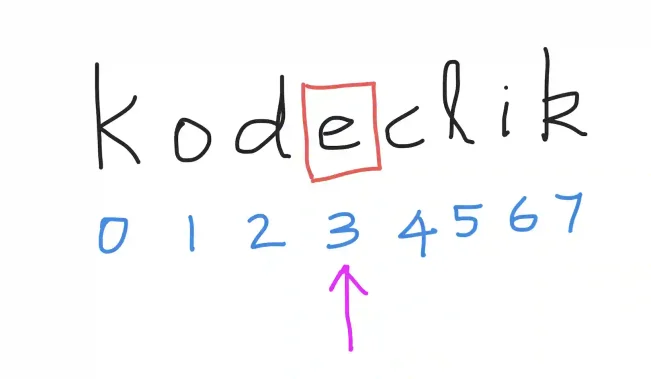Kodeclik Blog
How to print the nth character of a Python string
Accessing the nth character of a string is a fundamental operation in programming and is useful in various scenarios.
Let us explore three different ways to print the nth character of a Python string using the example string "Kodeclik". For instance, the fourth character of the string is the letter "e".

Method 1: Use indexing ([]) notation
In Python, strings are indexed starting from 0, meaning the first character is at index 0, the second at index 1, and so on. To access the nth character, we use the indexing operator [] with n-1 as the index. Consider:
s = "Kodeclik"
n = 3 # 0-based index, so this gives the fourth character
print(s[n])In this example, s[3] refers to the fourth character of "Kodeclik", which is "e". The output will thus be:
eMethod 2: Use next() with iter()
This is a little bit of an unconventional approach.
s = "Kodeclik"
n = 3
print(next(iter(s[n])))Here, we use iter() to create an iterator over the substring s[n], which consists of just one character. The next() function retrieves the first element from this iterator, which is simply the character itself. While this approach may seem unconventional, it still effectively retrieves the nth character. This method is somewhat redundant compared to direct indexing, but it demonstrates how iterators can be used to work with strings. Again the output will be:
eMethod 3: Use islice() from itertools
This approach uses the islice() function from the itertools module to extract the nth character.
from itertools import islice
s = "Kodeclik"
n = 3
print(next(islice(s, n, None)))Here, islice(s, n, None) slices the string starting at index n and produces an iterator. We then use next() to fetch the first character from this iterator, which corresponds to s[n]. This method is useful when working with very large strings or streams, as it avoids materializing unnecessary parts of the string in memory.
Again the output is:
eEach of these methods effectively retrieves the nth character, but indexing (s[n]) remains the most straightforward and commonly used approach. The iterator-based methods provide alternative ways of accessing elements, particularly useful in more complex iteration scenarios.
Now that you have seen how to access and print the nth character of a Python string, here are situations where you would need this capability:
Parsing and Processing Strings
When processing text data, you might need to extract specific characters based on position. For example, if you have a standardized format like a product code or an ID, you may need to extract certain portions for validation.
product_code = "A12345B"
category = product_code[0] # Extract first character as category identifier
print(category) # Output: AIn this case, the first character represents the category of the product, and extracting it allows further classification.
String Validation (Checking a Specific Character)
If you are validating input formats like email addresses, phone numbers, or identifiers, you might check specific characters at fixed positions.
phone_number = "+1234567890"
if phone_number[0] != "+":
print("Invalid phone number format.")Here, we ensure that the phone number starts with "+", which is necessary for international numbers.
Detecting Special Patterns (e.g., File Extensions)
When working with filenames, you might need to check specific characters. Some file extensions, for instance, have a specific character structure.
filename = "document.txt"
if filename[-3] == "t" and filename[-2] == "x" and filename[-1] == "t":
print("This is a text file.")This checks the last three characters of the filename to verify if it is a .txt file.
Cryptography and Security (Shuffling or Encoding)
Many encryption techniques, like simple ciphers, involve modifying specific characters.
message = "hello"
encrypted = message[0] + chr(ord(message[1]) + 2) + message[2:]
print(encrypted) # Slightly altered version of the original stringHere, we modify only the second character by shifting its ASCII value, which can be part of a basic encryption mechanism.
Natural Language Processing (NLP)
In NLP tasks like tokenization or character-based text analysis, you may need to access individual characters to identify letter patterns, punctuations, or whitespace.
text = "Hello, world!"
if text[5] == ",":
print("There's a comma at position 5.")This checks if a comma is present at a specific index, which can be useful for text preprocessing.
State Machines & Automata
In computational linguistics or formal languages, character positions matter. For example, a finite-state machine processing an input string may need to check characters at specific positions to transition between states.
command = "X10Y20"
if command[0] == "X":
print("Move in the X direction")This helps parse commands in a structured input format.
Summary
In summary, accessing the nth character is useful in data validation, text processing, file handling, security, NLP, and even automation. Whether you're analyzing structured data, processing user input, or implementing algorithms, indexing characters is a powerful tool. As we saw in the methods above, you can either directly index into the string, use an iterator, or use one of the slicing functions provided as part of the itertools module. Which approach is your favorite?
Enjoy this blogpost? Want to learn Python with us? Sign up for 1:1 or small group classes.